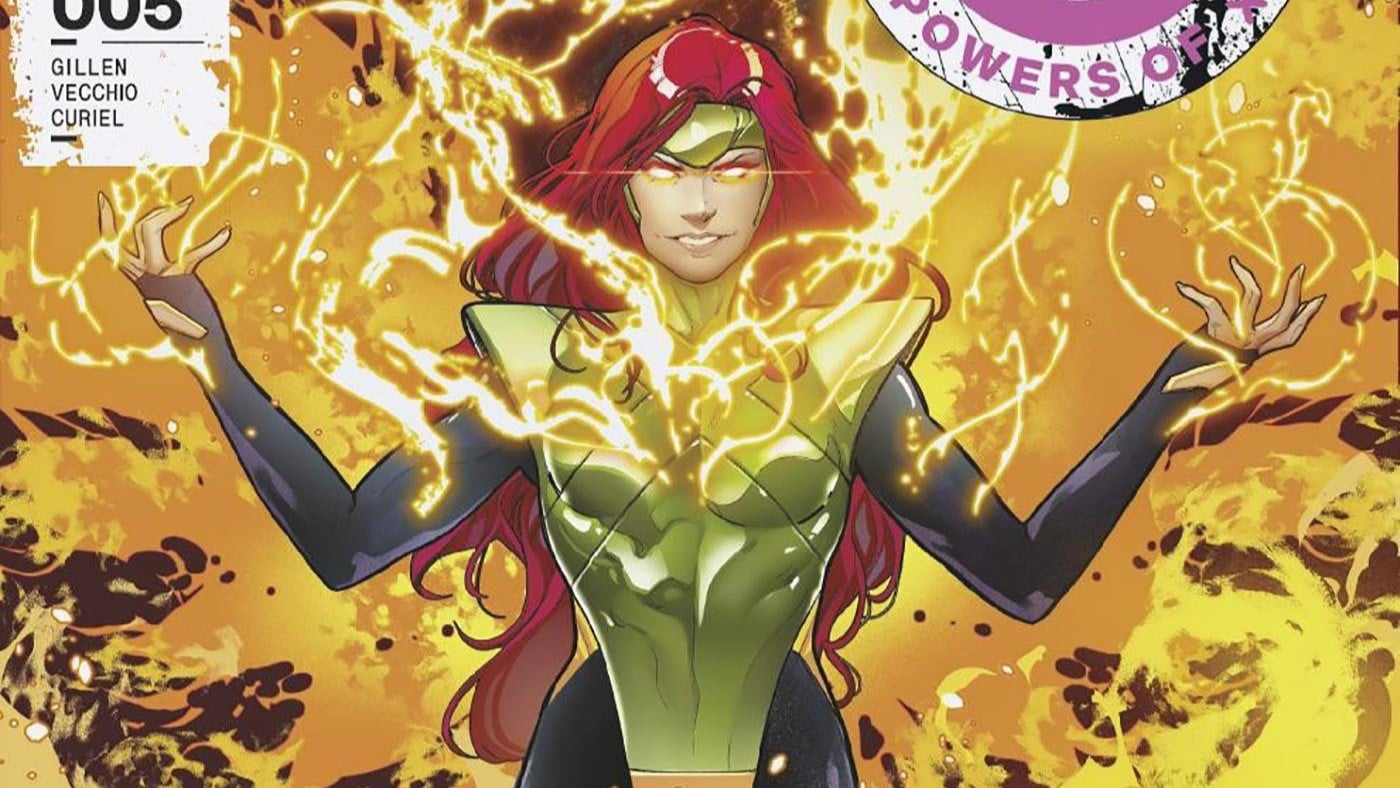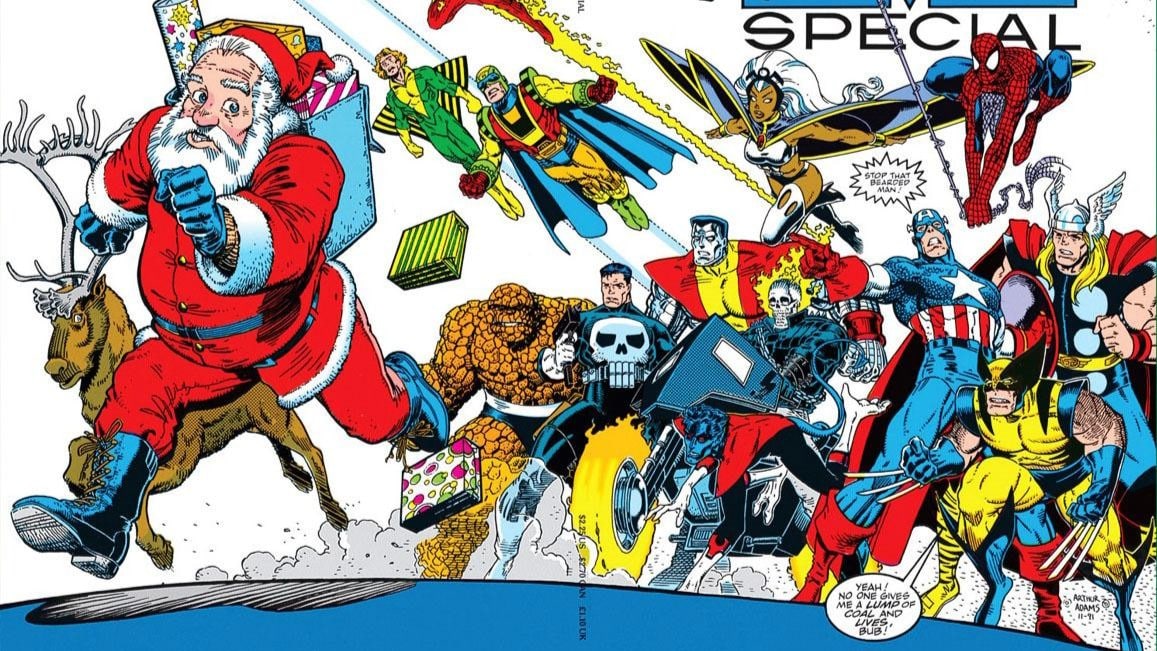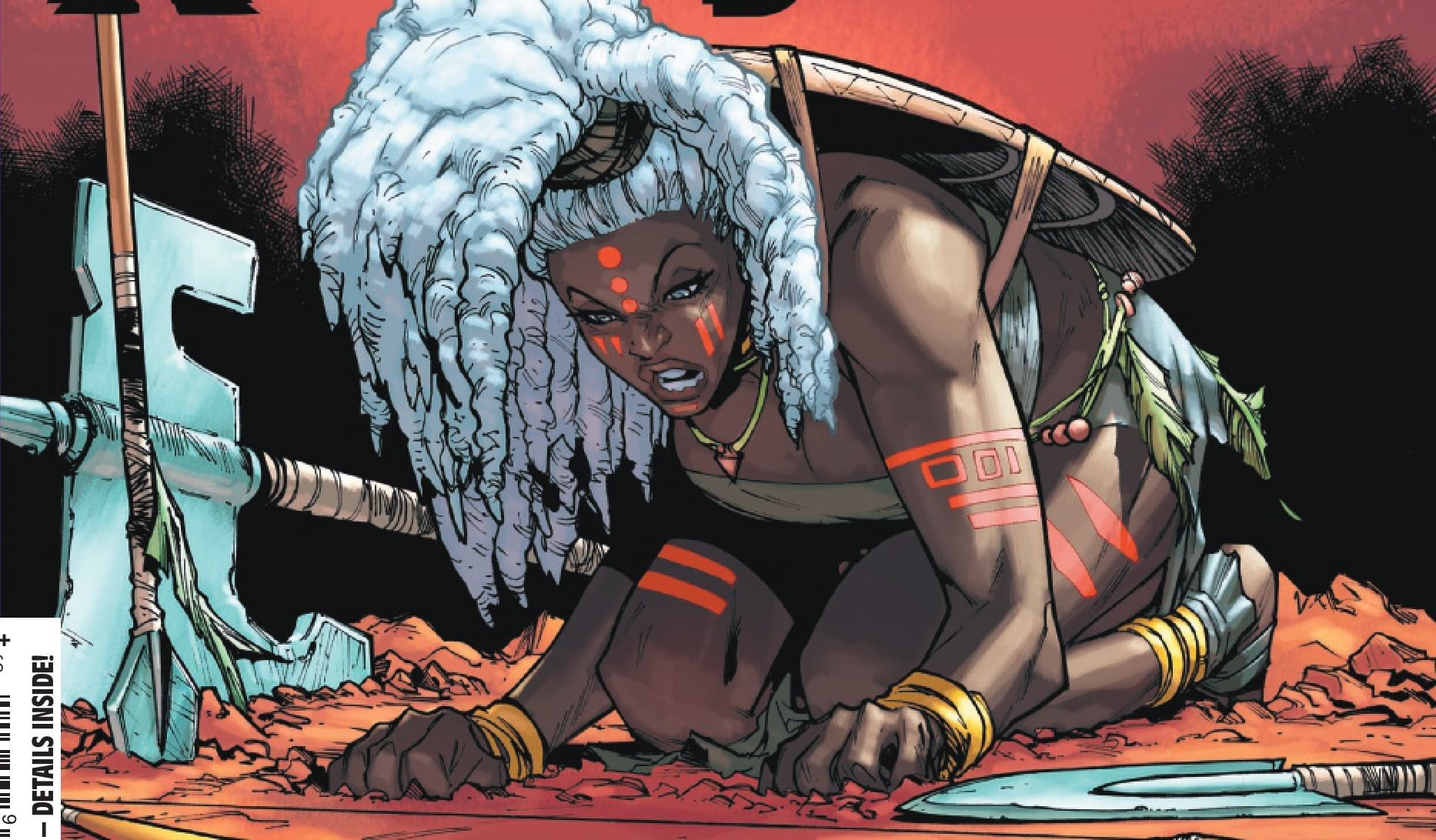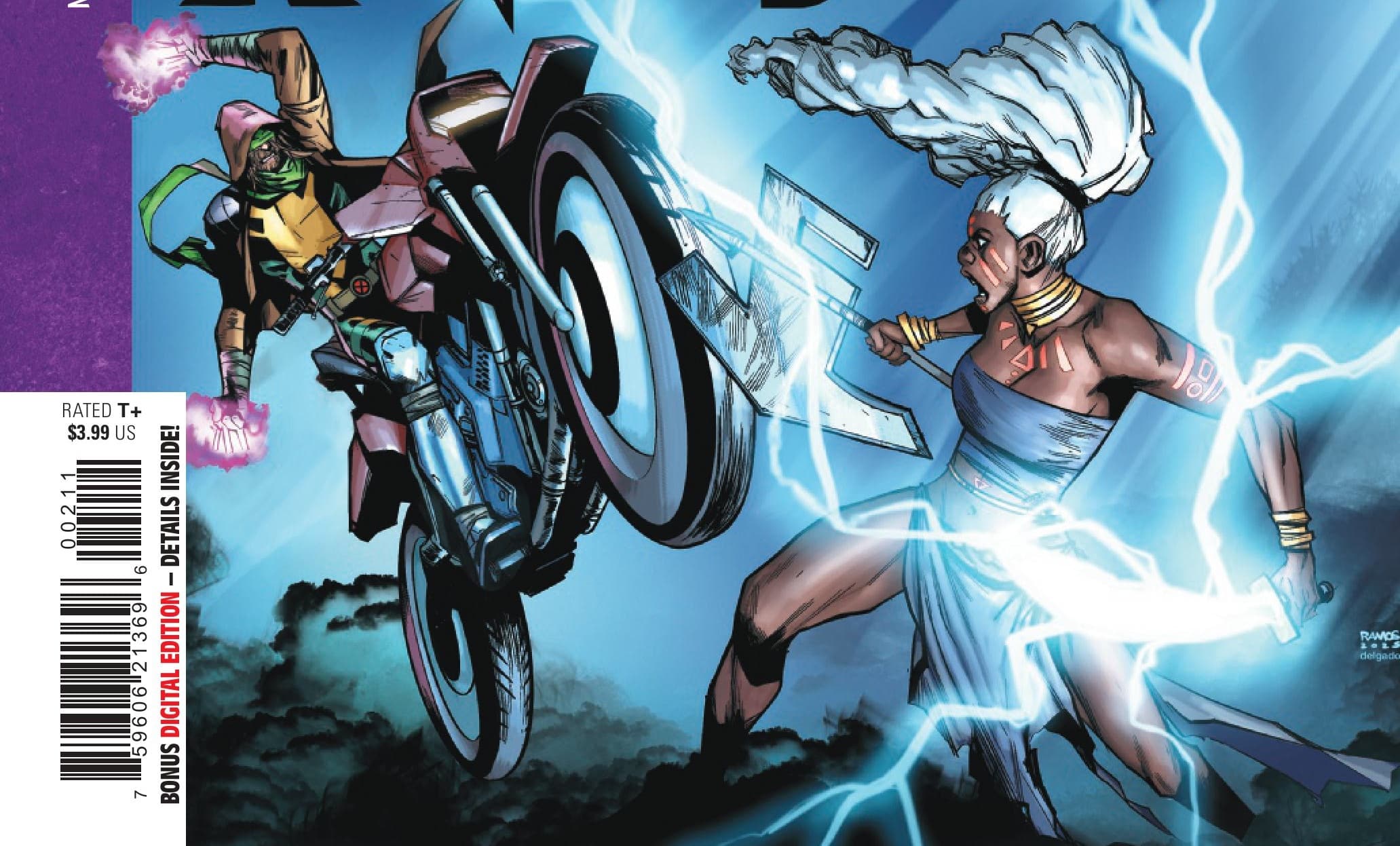It’s the final battle against Enigma as Phoenix rises, Xavier schemes and Moira faces a crucial decision in Rise of the Powers of X #5, written by Kieron Gillen, drawn by Luciano Vecchio, colored by David Curiel and lettered by Clayton Cowles.
Jake Murray: And thus ends the penultimate (ish) issue of the Krakoa era. When you’re operating on the scale of extra-universal concepts, as Kieron Gillen has through the second half of his Krakoan era X-Men odyssey, everything feels consequential. But here it is doubly so. Powers of X represented the death of many of the preconceived notions about mutants and about the X-Men while rebirthing an entirely new paradigm. Rise of the Powers of X is its spiritual counterbalance and it too is concerned with death and rebirth, of the Krakoa era, and beyond.
The contextual meaning of what it is saying goodbye to, and what will take its place, is something that I’ve preoccupied myself with a lot lately. So I placed a lot of significance onto this issue going in. And somehow under all that weight of expectation, this issue broadly delivered for me.
Armaan Babu: It was the kind of ending we didn’t know we could have — one that gave us some measure of satisfaction. I say “some” — there are a lot of decisions that are made here that I’m unhappy with. On the whole, however, this last part of the story was told well — assuming, of course, I’m not just settling for crumbs after everything that Fall of X as a whole has been.
Now and forever, I will be grumpy about it.
Dominion, it was really nothing

Jake: As has been teased since House of X / Powers of X, it’s finally time for Jean Grey and the Phoenix to take on Enigma. In the first five pages of the issue, Gillen builds on the contrast that already existed between the Phoenix, whose powers of creation and destruction and love and hatred are learned from its connection to humanity, and Enigma, who achieved power by stripping himself of his. We learn that Phoenix is now powered by its connection to “every mutant. Now and Forever”, that it has harnessed the power of community and human connection that the idealized version of Krakoa represented.
Armaan: There is another way to look at this. Think of the last time Jean and the Phoenix were one — Jean was moving past it. Jean had, in fact, grown beyond it, and one of my favorite lines from soon after it happened was Jean talking about how the Phoenix had always been holding her back.
And the Phoenix has, in many ways, held the X-Men back, on a narrative level. It’s their deus ex machina. Their comfort zone, for when Marvel’s scraping the bottom of their Ideas barrel. The Phoenix is something that other adaptations of the X-Men just can’t escape either — no matter how consistently all of them are worse in comparison to the original Phoenix Sagas.
With this move, so much is undone. We lose the concept of resurrections — something which challenged X-writers to do more, to find new stakes for these characters who we all know will keep coming back anyway. We lose Wanda’s one gesture of goodwill towards the mutant race, closure to an arc that had been hanging over her head since M-Day. We lose the idea that any mutants but the “fighting mutants” matter.
The Phoenix is the X-Men’s crutch — and they are now all bound to it more completely than they ever have been before. Now, and forever.
That’s not to say that that this is not an interesting development. That the Phoenix is so inextricably part of X-Men mythos with this storyline instead of simply being a cosmic being who liked the cut of Jean’s psychic jib is a fascinating development, one I think future writers can do fascinating things with. I simply don’t think this situation is ideal. But to be fair to the creative team, I think that there’s enough space in the story for that interpretation to work, as well. The Phoenix may be a step forward for mutantkind, it may be a step back. But either way, for this particular hand that was dealt? It was a step that needed to happen, and as rushed as things have been, that part feels earned.
Jake: It did. I love the idea of Phoenix harnessing the collective power of mutantkind in a way that Krakoa never could. In contrast to a Dominion, everyone retains their individuality while given a part of themselves to the Phoenix. It’s very much an idealized version of Krakoa, or of any utopia, in fact. I just wish that, rather than framing the power of mutants as the X-Men specifically, it was a little more aligned with the “Krakoa is for all mutants” ideology.
Meanwhile, the premise that Enigma based his argument on is a reflection of the limitations of his worldview and he is summarily rejected by his counterparts. In always seeing “others as others rather than possible-sames”, in seeking to destroy rather than commune, he has fundamentally misunderstood the math. He is very much the human who spawned him, and as such his close-mindedness and failure of imagination is what holds him back. It’s thematically aligned with Nimrod’s failure to account for Storm as the last X-Man but explained much more clearly and, despite the sci-fi nonsense of it all, is way more logical.
Armaan: Luciano Vecchio and David Curiel give us a very cool concept for what a collection of Dominions might look like – they look like too much. Their very existence seems to want to vibrate off the page, as if one reality isn’t enough to hold them all, is straining against the weight of their power.
Though their “We’re not here to fight you after all” speech is a bit of a let down, the logic is sound, within the framework of the story. From their timeless point of view, individuals are merely an illusion, a lie, a story of the past when time does not apply to them. If the Dominions exist, then they have won. They stay winning by simply existing.
The hubristic Enigma, however, lessened himself — and that’s what I like about this speech from the Dominions the most. They lay out Enigma’s ultimate weakness, why he’s been such an ineffectual villain despite being a god beyond all time and space. It’s because he refused to be beyond. He made himself the ultimate villain of the story. But to do that, he had to lower himself from godhood to become a part of the story. Stories have a linearity to them, and once you’re caught up in a story, you’re bound by its rules, especially in the Marvel Universe.
It’s a page that retroactively undid all the complaints I’ve had about Enigma as a character on the meta level that Gillen does so well — which made the following sequences that much more interesting. Acting far too late, Enigma tries to unravel the threads of Jean and the Phoenix’s story before they can begin. But the Phoenix outpaces him at every turn. We now know that the Phoenix quite literally embodies the X-Men; she is their story, and that’s something that no AI can pick apart.
Jake: What is super impressive to me considering he’s effectively a fill-in for this issue is that artist Luciano Vecchio is able to convey all of this with his page layouts and panelling. He, in tandem with colorist David Curiel, has demonstrated to great effect his ability to distil huge cosmic concepts into clear and concise imagery in Resurrection of Magneto. Their work here is equally brilliant.
The Phoenix, embodied by Jean, is both sitting above and existing within every page, an effect that’s accentuated by heavy inking and panel-less pages. Her figure is simultaneously beyond the story as you described it and woven into its very fabric. She is interconnected to the White Hot Room and by extension every mutant within it. She singes the very fabric of where panels would typically be, freeing the story from the confines of convention.
By contrast, Enigma becomes more constrained by paneling as the issue goes on. Where he previously dominated the page, dwarfing the lone figure of Jean as Dominions illuminated behind him, all of a sudden he is left alone. The panels begin to cut across him, confining him within the narrative. As he attempts to trap Jean in her own memories, he can’t help but place his crown in the middle of the timelines, which create panels like fault lines on the page.
Enigma again tries to assert his dominance over the story. He looms large. But the figure of the Phoenix simply moves beyond the confines of the page, filling it and eventually herself with an infinite number of X-Men. To your earlier point, she both exalts the X-Men to godhood and holds them back. Eventually, Enigma is reduced to ‘just another X-Men villain’, his life ended by three Adamantium claws by the best in the biz.
Armaan: I truly, unironically, love this moment. For all that I enjoy the way Gillen mixes cleverness and emotional resonance in his writing, what I also love about his writing is that he gets that comics can be very, very stupid in ways that are incredible. Wielding the focused totality of the spirit of every X-Man who’s ever died in the familiar form of one of the most popular X-Men ever to defeat a malevolent entity that’s beyond space and time…that’s comics.
The Two Prisoners

Armaan: The Krakoa era cannot end, of course, without one last confrontation with the one who made it all possible: Moira MacTaggert. With the Sentinels dropping like flies over in the other X-books, Professor X is left more or less alone for Moira to try and figure out what exactly he thinks he’s doing.
It turns out that Charles’ team-up with ORCHIS was all a part of his plan to get a moment alone with Moira. I do appreciate that this plan does not exonerate him of the things he’s done. Nor does this story in any way ask us to think Charles’ dark deeds were in any way worth it, that there is any justification for what he’s done. We just know the why of it — the plan — and at the end of the day, Charles is every bit the monster he desperately wishes he wasn’t.
Importantly, though — he’s someone who’s at the right place, at just the right time. As the Phoenix and Enigma try to undo each other across all of time and space, Charles and Moira have a little heart-to-heart in Charles’ mindscape, in his nostalgia. A safe space, for him and Moira, as he tries to appeal to her humanity. The hows and whys of it are wrapped in comic book gobbledygook, but the essence of it is this: Enigma can only be defeated if Moira agrees to sacrifice her life to make it happen.
It shouldn’t work. Not for the readers, and certainly not for Moira — and honestly, if the Fall of X had been better written, this ending here would not work at all. Given how extremely Moira’s turned ever since Inferno, and how little the words of Xavier should weigh, nothing about this moment feels earned.
But.
But we’re tired. The Fall of X has been one exhausting disappointment after another. Everyone new tie-in issue has been trying to race to the end of the Krakoan era as fast as possible…and at this point, we’re tired.
It’s not a perfect ending. It’s not even an especially good one. But there are tears in Xavier’s eyes. Pain, betrayal, anger and resignation in Moira’s. It’s not a good story, but the words and pictures and panels fit the shape of what a good story should be, and so here, and now…it’s good enough.
Jake: You’re absolutely right. It did make me laugh though that it was the sheer persistence of Charles Xavier’s idealism just bulldozing its way through all other characters’ motivations that won the day. You can have your Phoenixes and your Dominions and your Sinisters: this is the X-Men distilled to its simplest form. His argument, for what it’s worth, pretty much hinges on “I know I’m an asshole, but you know who’s even worse? You guessed it: Nathaniel Essex”.
And who can argue with that?
In all seriousness though, this scene to me represented a metatextual passing of the narrative torch, or a death and a rebirth, however you want to put it, from Moira back to Charles. Five years ago Jonathan Hickman changed the X-Men ostensibly forever by transferring control of the X-Men story from Charles Xavier to Moira MacTaggert. Throughout the X-Men’s history, even when he hasn’t been present, everything that happens is in service of or opposition to Charles Xavier’s dream. House of X #2 put Moira at the epicenter of X-Men stories in a way that hadn’t been done before. Her motivations, her life, her dream became the driving force for everything that happened within the broader X-Men story.
Sadly, subsequent stories lost track of that. Reduced to a robot villain caricature by most writers, this ending is the disappointingly-inevitable conclusion to the continual diminishing returns because it’s effectively Moira giving up her story for Charles’. Yes, everything gets put back together for Moira, but this happens so miraculously it just serves as a reminder what a colossal let down her story arc has been.
The ending works perfectly for Charles. Both a martyr and pariah, the “From The Ashes” era starts with Charles Xavier as its central figure, the framework around which everything else is defined. Prisoner X is here.
Beginnings and Endings and Beginnings and Endings

Armaan: This isn’t the final issue of this era. But it does, tidily, wrap up a lot of important things. Enigma isn’t dead — for can a Dominion trully be killed? He is dying, all the time, throughout all of time and space. The 616 reverberates with an eternal scream through its eternity, a warning to those that would see that universe as prey. As cosmic comics mythology goes, that is badass — and terrifying.
Jake: I loved this conclusion too. He was reduced from a splash page to a never ending data page over the course of the issue. Krakoa detractors would say that this is apt, but I couldn’t possibly comment.
Armaan: Our more mortal, diamond-foreheaded Mister Sinister sneaks away, to antagonize the X-Men another day. Mystique and Destiny scamper off into their Pride Month Wedding Issue — after all, what care they for Krakoa, when they have each other and the Big Threat is finally off the table?
Jake: I can’t help but think that when Destiny told Sinister, “the second kindest thing I can do for you Sinister? Is not share what I’m seeing”, it may have been a graphic detailing of what Rasputin would have done to Sinister if he’d stayed. Gillen has been invested in their connection throughout his run, and I think this was one last favor from frenemy to frenemy before the two go their separate ways for who knows how long.
I can’t help but feel a little bit disappointed by the conclusion to Sinister’s story. That’s probably because what I would have wanted to see would be a mirror of the scene in Airplane! where a queue of passengers prepare to hit another with increasingly large objects. While it’s very funny that Gillen saved his favorite villain, it’s also completely appropriate that Sinister didn’t get his comeuppance because he is simply not capable of empathy. Quite the opposite in fact: he learned to feign humility to save his hide on a couple of occasions. It may not be satisfying, but it’s infuriatingly fitting.
Armaan: One last data page for this particular series ties up the messy timelines in a neat little bow. Moira’s life was not undone. Everything that’s happened in the Krakoa era did still happen, and the stories going forward are in that timeline’s aftermath, while Moira gets to live her life out in a new timeline, an 11th one – finally free, it would seem, of the weight of destiny (no, not that Destiny).
Jake: It very much ties everything up for the next era. But calling the new home for the thousands of mutants the incoming writers and editors don’t want to do anything with (or are narratively-inconvenient like The Five-minus-one) “New Krakoa” sticks in the craw for me. The out-of-story reasons are so transparent that it almost feels insulting to pretend, as ROPOX and X-Men Forever do, that these mutants matter narratively.
Looking at the mutants who are left, they’re all the familiar names. The most human passing, the most useful in combat, the characters who perhaps capture the essence of the mutant people the least. They are the X-Men, and as Krakoa has reminded us, mutantkind is more than the X-Men. Dressing up purgatory as a paradise is just disingenuous but: the creators had a job to do, and they did it.
Armaan: It’s about as well done as we could hope for. All the right beats are there. A sense of finality. A sense of hope. Tired heroes wandering into a brighter day — with just enough loose ends left lying around to keep stories churning out ad infinitum.
This, here, is as good an ending as the Krakoan era is likely to get, I think. I’m almost afraid to read Uncanny X-Men #700 nee X-Men #35 now.
Jake: I’m trying to decide whose last line sums up my state of mind. Is it Xavier’s, “I should have done this sooner, but I had to think… I wanted to say goodbye? I’m sentimental. Now… take me away and throw away the key.”?
Or is it Moira’s “I’m free. It’s over.”?
Give me another week or two.
Inside the RoPoX Tox Box
- Krakoan as Jean Grey rises reads: “Fire, life, fire, life, fire, life” — surprising no one.
- Big Giant Phoenix is composed of X-Men who are both currently alive and dead, from the past, present and alternate future — the Phoenix is not just the X-Men of the White Hot Room, but is “made of every mutant who has ever lived in any dimension ever”.
- Even Maggot.
- There is an interesting backdoor for writers who want to explore the non-fighting stories of nation-building X-Men in the White Hot Room — but given the solicits we’ve seen, that door’s not going to be open for a while.







